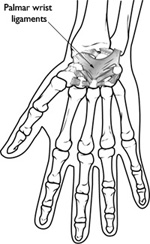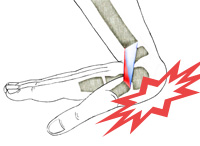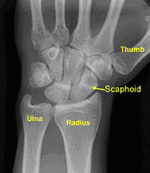
Wrist Sprains
A sprain is an injury to a ligament. Ligaments are strong bands of connective tissue that connect one bone to another.
A wrist sprain is a common injury. There are many ligaments in the wrist that can be stretched or torn, resulting in a sprain. This occurs when the wrist is bent forcefully, such as in a fall onto an outstretched hand.
Description Many ligaments support the wrist.
Many ligaments support the wrist.
Wrist sprains can range from mild to severe. They are graded, depending on the degree of injury to the ligaments.
- Grade 1. These mild sprains occur when the ligaments are stretched, but not torn.
- Grade 2. These moderate sprains occur when the ligaments are partially torn. Grade 2 sprains may involve some loss of function.
- Grade 3. These severe sprains occur when the ligament is completely torn. These are significant injuries that require medical or surgical care. As the ligament tears away from the bone, it may also take a small chip of bone with it, called an avulsion fracture.

Wrist sprains are most often caused by a fall onto an outstretched hand. This might happen during everyday activities, but frequently occurs during sports and outdoor recreation.
SymptomsSymptoms of a wrist sprain may vary in intensity and location. The most common symptoms of a wrist sprain include:
- Swelling in the wrist
- Pain at the time of the injury
- Persistent pain when you move your wrist
- Bruising or discoloration of the skin around the wrist
- Tenderness at the injury site
- A feeling of popping or tearing inside the wrist
- A warm or feverish feeling to the skin around the wrist
Sometimes, a wrist injury may seem mild with very little swelling, but it could be that an important ligament has been torn that will require surgery to avoid problems later.

Similarly, an unrecognized (occult) fracture may be mistakenly considered a mild or moderately sprained wrist. If left untreated, the broken bone may not heal and will require a surgery that could have been avoided with early, appropriate treatment. The most common example of this is an occult fracture of the scaphoid bone.
It is important in all but very mild cases for a doctor to evaluate a wrist injury. Proper diagnosis and treatment of wrist injuries is necessary to avoid long-lasting stiffness and pain.
Doctor ExaminationYour doctor will discuss your medical history and any previous injuries to your hand or wrist. He or she will ask questions about how and when the current injury happened, and will review all your symptoms, including asking about any numbness in your hand.
Your doctor will examine your entire arm and hand to make sure that there are no other injuries. Tenderness in certain areas may suggest a broken bone.
Partial ligament tears are sometimes difficult to diagnose, but may cause re-occurring (chronic) disability if not treated surgically. Every effort should be made to properly diagnose the cause of persistent pain in a sprained wrist.
Imaging Tests
Your doctor may order imaging tests to help determine whether your wrist is sprained.
X-rays. Although they will not show an injury to the ligament, x-rays can show whether the injury is related to a broken bone.
Other tests. In some cases, a magnetic resonance imaging (MRI) scan, computed tomography (CT) scan, or arthrogram may also be ordered. An arthrogram involves the injection of some dye into the joint. This makes the joint and ligaments show up more clearly.
TreatmentFirst Aid
Mild wrist sprains can usually be treated at home with the RICE protocol.
- R Rest the joint for at least 48 hours.
- I Ice the injury to reduce swelling.
Do not apply ice directly to the skin. Use an ice pack or wrap a towel around the ice or a package of frozen vegetables. Apply ice for about 20 minutes at a time. - C Compress the swelling with an elastic bandage.
- E Elevate the injury above the level of the heart.
A pain reliever, such as aspirin or ibuprofen, may be helpful. If pain and swelling persist for more than 48 hours, however, see a doctor.
Nonsurgical Treatment
Moderate sprains may need to be immobilized with a wrist splint for 1 or more weeks. This immobilization may cause some stiffness in your wrist and your doctor may recommend some stretching exercises to help you regain full mobility.
Surgical Treatment
Severe sprains may require surgery to repair the fully torn ligament. Surgery involves reconnecting the ligament to the bone. Your doctor will discuss the surgical options that best meet the needs of your injury.
Surgery is followed by a period of rehabilitation and exercises to strengthen the wrist and restore motion. Although the ligament can be expected to heal in 6 to 8 weeks, rehabilitation with full recovery of motion and strength can take several months. This depends on the severity of the sprain.
PreventionBecause wrist sprains usually result from a fall, be careful when walking in wet or slippery conditions. Wrist sprains also occur during sports, such as skating, skateboarding, and skiing. Wrist guard splints or protective tape can be used to support the wrist and prevent it from bending too far backward. When skiing, drop the poles during a fall to prevent wrist sprains.
Source: http://orthoinfo.aaos.org/topic.cfm?topic=A00023
